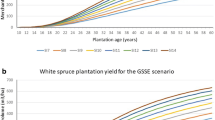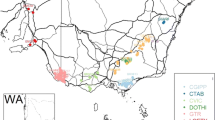Abstract
Scots pine (Pinus sylvestris) seedlots of different genetic quality were compared in realised gain trials at six sites in southern Finland at an age of 14–15 years. Synthetic seedlot mixtures of 1.5-generation plus trees showed consistent superiority to both first-generation orchard seedlots and unimproved checklots in growth, slenderness and relative branch size. Open-pollinated offspring from first-generation orchards, in turn, outperformed unimproved trees in most growth and quality traits. The mean incidence of ramicorns and forks was similar between unimproved and first-generation orchard trees, but slightly elevated in the 1.5-generation stock. Stand-level yields were projected for two virtual sites in southern Finland using simulation software MOTTI. The development of improved stands was modelled by incorporating genetic gains in height and diameter growth in the asymptote parameter of the Chapman–Richards growth function. The mean annual yields of the first-generation and 1.5-generation orchard stock were, as an average over the two sites, 11.5 and 23.9 % above the unimproved stock, respectively. For juvenile, fully contaminated 1.5-generation orchards, the genetic gain was 15.9 %. The predicted reduction in the length of commercial rotation due to genetic improvement varied between 4 and 17 years depending on the site, orchard generation, level of pollen contamination and genetic thinning. The results indicated substantial returns on investments on improved reforestation stock in southern Finland. Increments in bare land value (using a 3 % interest rate) ranged from 529 to 1836 € ha−1 (30.5–60.5 % above unimproved stock).


Similar content being viewed by others
References
Ahtikoski A, Ojansuu R, Haapanen M, Hynynen J, Kärkkäinen R (2011) Financial performance of using genetically improved regeneration material of Scots pine (Pinus sylvestris L.) in Finland. New For. doi:10.1007/s11056-011-9284-6
Ahtikoski A, Salminen S, Ojansuu R, Hynynen J, Kärkkäinen K, Haapanen M (2013) Optimizing stand management involving the effect of genetic gain: preliminary results for Scots pine in Finland. Can J For Res 43:299–305
Andersson B, Elfving B, Ericsson T, Persson T, Gregorsson B (2003) Performance of Improved Pinus sylvestris in Northern Sweden. Scand J For Res 18(3):199–206
Andersson B, Elfving B, Persson T, Ericsson T, Kroon J (2007) Characteristics and development of improved Pinus sylvestris in northern Sweden. Can J For Res 37(1):84–92
Antola J, Haapanen M (2014) Finnish Elite Seed Orchard Programme: a progress report. 2014 IUFRO forest tree breeding conference in Prague, Czech Republic, 25–29 August 2014. p. 66
Antola J, Hahl J (1995) Männyn 1,5 polven siemenviljelyksen kloonivalinta. Metsänjalostussäätiön työraportteja 22: 1–16 [In Finnish: Selection of clones for the 1.5 generation seed orchards of Scots pine]
Baltunis BS (2005) Genetic effects of rooting ability and early growth traits in loblolly pine clones. PhD thesis, University of Florida
Buford A, Burkhart H (1987) Genetic improvement effects on growth and yield of loblolly pine plantattions. For Sci 33(3):7070–7724
Cannell MGR (1997) Tree physiology and yield improvement. Academic Press, London
Carson S, Garcia O, Hayes J (1999) Realized gain and prediction of yield with genetically improved Pinus radiata in New Zealand. For Sci 45(2):186–200
Dhakal LP (1995) Realized genetic gains and validation of breeding values for Slash pine. M.S. thesis, School of Forest Resources and Conservation, University of Florida, Gainesville, FL
Dhakal LP, White TL, Hodge GR (1996) Realized genetic gains from Slash pine tree improvement. Silvae Genet 45(4):190–197
Evira (2016) Statistics from forest seed and seedling production. https://www.evira.fi/en/plants/cultivation-and-production/forestry/statistics/seed-and-seedling-production/. Accessed 3 May 2016
Finnish Statistical Yearbook of Forestry 2014. Finnish Forest Research Institute. 428 p
Funda T, Wennström U, Almqvist C, Torimaru T, Andersson Gull B, Wang X (2015) Low rates of pollen contamination in a Scots pine seed orchard in Sweden the exception or the norm? Scand J Forest Res 30(7):573–586. doi:10.1080/02827581.2015.1036306
Gould P, Marshall D (2010) Incorporation of genetic gain into growth projections of Douglas-fir using ORGANON and the forest vegetation simulator. West J Appl For 25(2):55–61
Gould P, Johnson R, Marshall D, Johnson G (2008) Estimation of genetic-gain multipliers for modeling Douglas-fir height and diameter growth. For Sci 54(6):588–596
Gwaze DP (1997) Genetic parameter estimates for height and stem straightness in Pinus taeda Linnaeus and implications for breeding. PhD thesis, University of Edinburgh
Haapanen M, Mikola J (2008). Metsänjalostus 2050 — pitkän aikavälin metsänjalostusohjelma [In Finnish: Forest Tree Breeding 2050—a plan for long-term tree breeding]. Finnish Forest Research Institute, working papers 71, pp 1–50
Haapanen M, Pöykkö T (1993) Genetic relationships between growth and quality traits in an 8-year-old half-sib progeny trial of Pinus sylvestris. Scand J Forest Res 8:305–312
Haapanen M, Velling P, Annala M (1997) Progeny trial estimates of genetic parameters for growth and quality traits in Scots pine. Silva Fennica 31(1):3–12
Haapanen M, Jansson G, Nielsen U, Steffenrem A, Stener L-G (2015) In: Stener L-G (ed) The status of tree breeding and its potential for improving biomassa production—a review of breeding activities and genetic gains in Scandinavia and Finland. Skogforsk. 55 p
Hahl J (1997) Tuloksia Etelä- ja Keski-Suomen kantamäntyjen jälkeläiskokeiden laatumittauksista. Metsänjalostussäätiön työraportteja 40: 1–29 [In Finnish: Results from the quality measurements of progeny trials in Southern and Central Finland]
Harju A, Nikkanen T (1996) Background pollination and pollination success during different stages of pollen shedding in a Scots pine seed orchard. Can J For Res 26(6):1096–1102
Hynynen J (1993) Self-thinning models for even-aged stands of Pinus sylvestris, Picea abies and Betula pendula. Scand J For Res 8(3):326–336
Hynynen J, Ojansuu R, Hökkä H, Salminen H, Siipilehto J, Haapala P (2002) Models for predicting stand development in MELA system. Finn For Res Inst Res Pap 835:1–116
Hynynen J, Ahtikoski A, Siitonen J, Sievänen R, Liski J (2005) Applying the MOTTI simulator to analyse the effects of alternative management schedules on timber and non-timber production. For Ecol Manage 207:5–18
Hynynen J, Salminen H, Ahtikoski A, Huuskonen S, Ojansuu R, Siipilehto J, Lehtonen M, Rummukainen A, Kojola S, Eerikäinen K (2014) Scenario analysis for the biomass supply potential and the future development of Finnish forest resources. Working papers of the Finnish Forest Research Institute 302. 106 p
Hynynen J, Salminen H, Ahtikoski A, Huuskonen S, Ojansuu R, Siipilehto J, Lehtonen M, Eerikäinen K (2015) Long-term impacts of forest management on biomass supply and forest resource development: a scenario analysis for Finland. Eur J For Res 134:415–431. doi:10.1007/s10342-014-0860-0
Jansson G (2007) Gains from selecting Pinus sylvestris in southern Sweden for volume per hectare. Scand J For Res 22:85–192
Kang KS, Bila AD, Harju AM, Lindgren D (2003) Estimation of fertility variation in forest tree populations. Forestry 76:330–344
Kimberley M, Moore J, Dungey H (2015) Quantification of realised genetic gain in Radiata pine and its incorporation into growth and yield modelling systems. Can J For Res 45(12):1676–1687
Kojola S, Ahtikoski A, Hökkä H, Penttilä T (2012) Profitability of alternative management regimes in Scots pine stands on drained peatlands. European J For Res 131(2):413–426
Laasasenaho J (1982) Taper curve and volume functions for pine, spruce and, birch. Communicationes Instituti Forestalis Fenniae 108. 74 p
Littell R, Milliken G, Stroup W (2006) SAS for mixed models, 2nd edn. SAS, Cary
Lynch M, Walsh B (1998) Genetics and analysis of quantitative traits. Sinauer Assocs Inc, Sunderland
Matsiris DI (2000) Genetic variation and realized genetic gain from Aleppo pine tree improvement. Silvae Genetica 49(1):5–10
Nikkanen T, Ruotsalainen S (2000) Variation in flowering abundance and its impact on the genetic diversity of the seed crop in a Norway spruce seed orchard. Silva Fennica 34(3):205–222
Nikkanen T, Karvinen K, Koski V, Rusanen M, Yrjänä-Ketola L (1999) Kuusen ja männyn siemenviljelykset ja niiden käyttöalueet [In Finnish]. (Norway spruce and Scots pine seed orchards and their deployment areas). Metsäntutkimuslaitoksen tiedonantoja 730:1–203
Pakkanen A, Pulkkinen P (1991) Pollen production and background pollination levels in Scots pine seed orchards of northern Finnish origin. In: Pollen contamination in seed orchards. In: Proceedings of the meeting of Nordic group for tree breeding, 20–22 Aug 1991. Edited by D. Lindgren. Rep 10. Department of Forest Genetics and Plant Physiology, Swedish University of Agricultural Sciences, Umeå (14–21)
Paques L (2013) Forest tree breeding in Europe: current state-of-the-art and perspectives. SpringerLink. 533 pp
Rantala S (ed) (2011) Finnish forestry practice and management. Metsäkustannus, Helsinki. 271 p. ISBN 978-952-56-9462-8
Richards FJ (1959) A flexible growth function for empirical use. J Exp Bot 10(29):290–300
Rosvall O, Jansson G, Andersson B, Ericsson T, Karlsson B, Sonesson J, Stener L (2001) Genetiska vinster I nuvarande och framtida fröplantager och klonblandningar. [Summary: Genetic gains from present and future seed orchards and clone mixes.] Redogörelse nr 1, Skogforsk, Uppsala
Ruotsalainen S, Persson T (2013) Scots pine—Pinus sylvestris L. In: Mullin TJ, Lee SJ (eds) Best practice for tree breeding in Europe. Skogforsk, pp 49–64
Salminen H, Lehtonen M, Hynynen J (2005) Reusing legacy FORTRAN in the MOTTI growth and yield simulator. Comput Electron Agric 49(1):103–113
SAS Institute Inc (2009) SAS/STAT 9.2 User’s guide, mixed modeling (book excerpt). SAS Institute Inc, Cary
Siipilehto J (2006) Linear prediction application for modelling the relationships between a large number of stand characteristics of Norway spruce stands. Silva Fennica 40(3):517–530
Siipilehto J, Mehtätalo L (2013) Parameter recovery vs. parameter prediction for the Weibull distribution validated for Scots pine stands in Finland. Silva Fennica 47(4):1–22
Smith BC, Bullock BP, Isik F, McKeand SE (2014) Modeling genetic effects on growth of diverse provenances and families of loblolly pine across optimum and deficient nutrient regimes. Can J For Res 44(11):1453–1461
St. Clair J (1993) Evaluating realized gains from tree improvement. In: Proceedings: IUFRO S4.01 conference. Blacksburg, VA. Publication FWS-1-93 of the College of Forestry, Virginia Polytechnic Institute, pp 145–157
Stoehr M, Bird K, Nigh G, Woods J, Yanchuk A (2010) Realized genetic gains in coastal Douglas-fir in British Columbia: implications for growth and yield projections. Silvae Genetica 59(5):223–233
Straka T (2010) Financial breakeven for competition control in longleaf pine (Pinus palustris Mill.) reestablishment. New For 40:165–173
Sweet G (1995) Seed orchards in development. Tree Physiol 15:527–530
Vergara R, White TL, Huber DA, Shiver BD, Rockwood DL (2004) Estimated realized gains for first-generation slash pine (var.) tree improvement in the southeastern United States. Can J For Res 34(12):2587–2600
Vuokila Y, Väliaho H (1980) Viljeltyjen havumetsiköiden kasvatusmallit. [In Finnish]. Summary: Growth and yield models for conifer cultures in Finland. Commun Inst For Fenn 99(2):1–271
White T, Adams W, Neal D (2007) Forest genetics. Oxford University Press, Oxford
Xiang B, Li B, McKeand S (2003) Genetic gain and selection efficiency of loblolly pine in three geographic regions. For Sci 49(2):196–208
Xiong J, McKeand S, Whetten R, Isik F (2014) Genetics of stem forking and ramicorn branches in a cloned loblolly pine family. For Sci 60(2):360–366
Ye TZ, Jayawickrama KJS, St. Clair JB (2010) Realized gains from block-plot coastal Douglas-fir trials in the Northern Oregon Cascades. Silvae Genetica 59(1):29–39
Yrjänä L, Karvinen K (2002) General statistics on forest tree breeding in Finland 2002. Finn For Res Inst Res Pap 854:1–47
Zeide B (1993) Analysis of growth models. For Sci 39(3):594–616
Zobel B, Talbert J (1984) Applied forest tree improvement. Wiley, New York
Acknowledgments
We would like to express our gratitude to Dr. Teijo Nikkanen who initiated the field trial series used in this study and to Dr. Risto Ojansuu for his efforts in incorporation of genetic multipliers into the MOTTI software.
Author information
Authors and Affiliations
Corresponding author
Additional information
Communicated by Aaron R Weiskittel, Ph.D.
Rights and permissions
About this article
Cite this article
Haapanen, M., Hynynen, J., Ruotsalainen, S. et al. Realised and projected gains in growth, quality and simulated yield of genetically improved Scots pine in southern Finland. Eur J Forest Res 135, 997–1009 (2016). https://doi.org/10.1007/s10342-016-0989-0
Received:
Revised:
Accepted:
Published:
Issue Date:
DOI: https://doi.org/10.1007/s10342-016-0989-0




